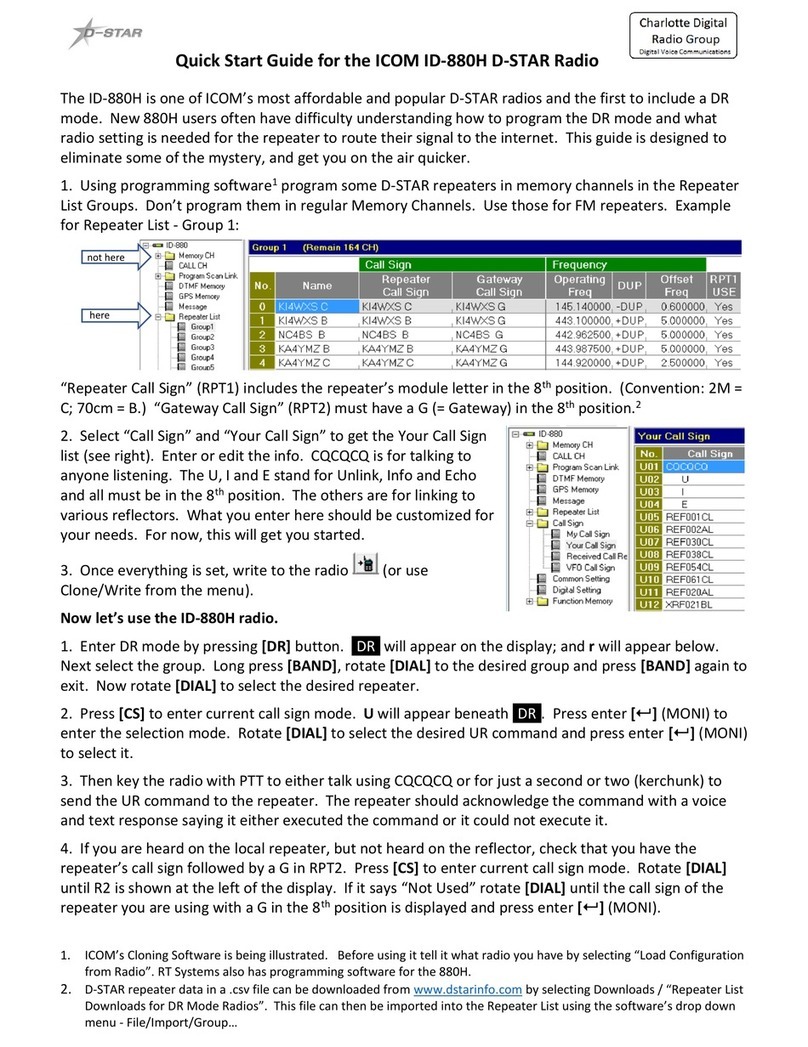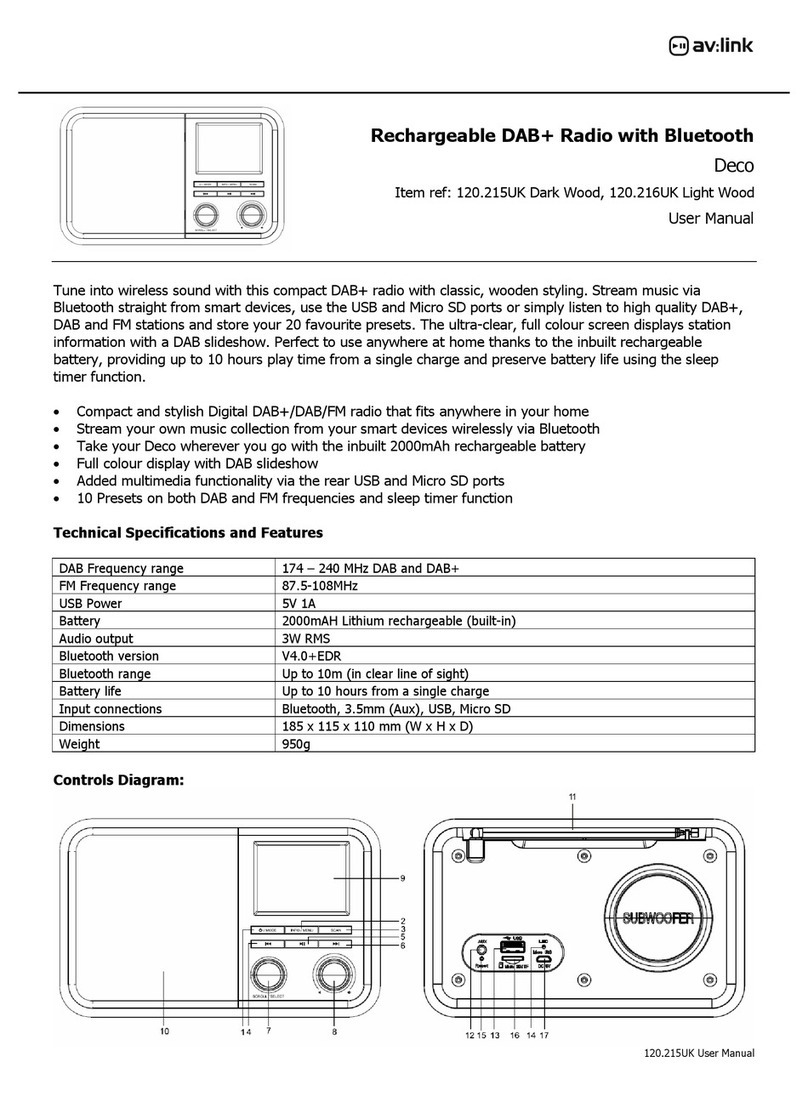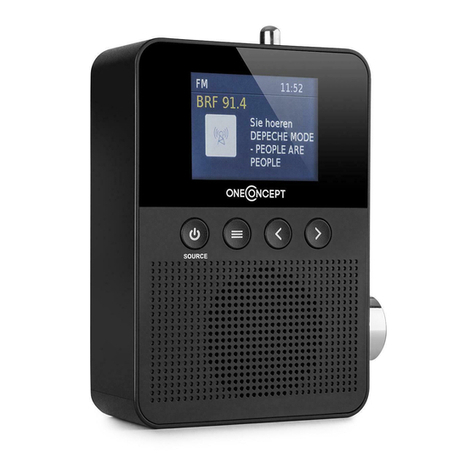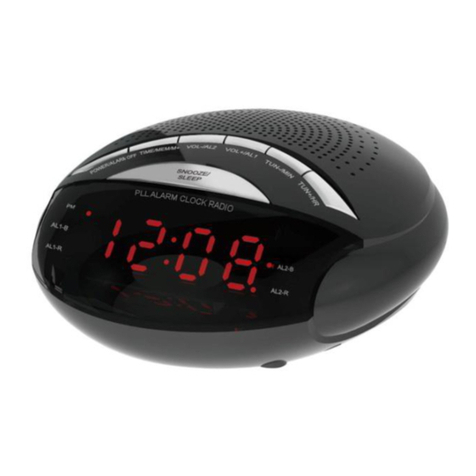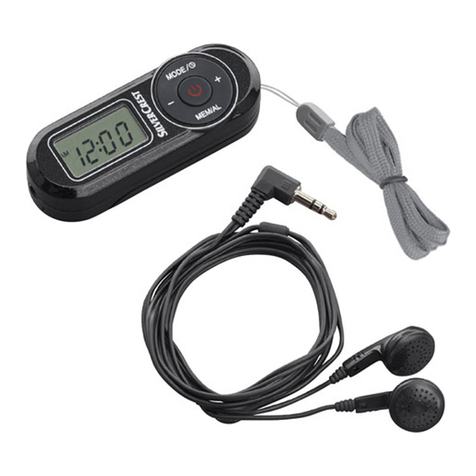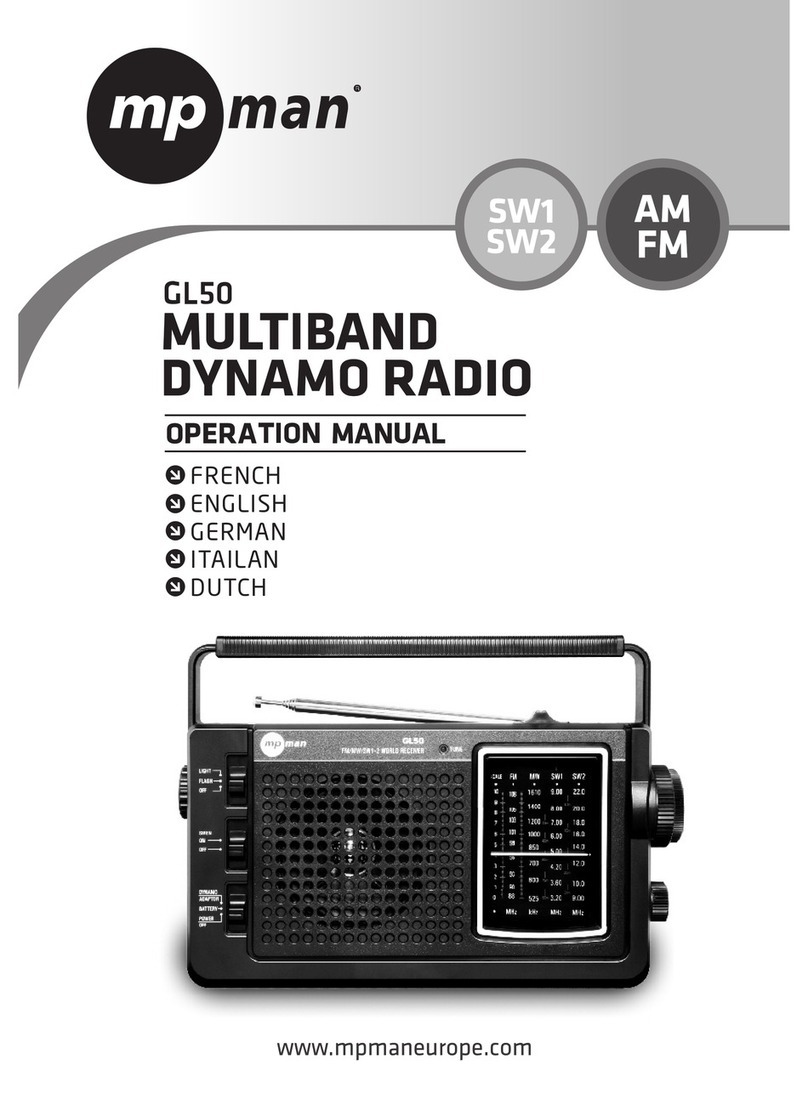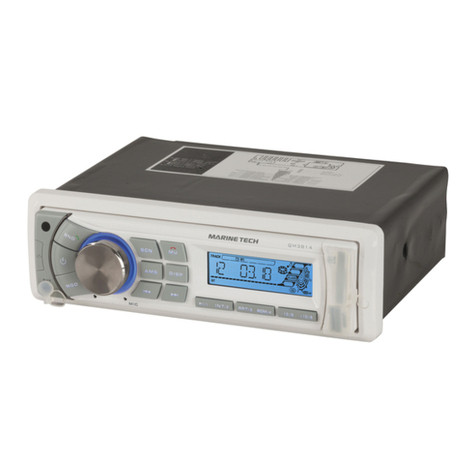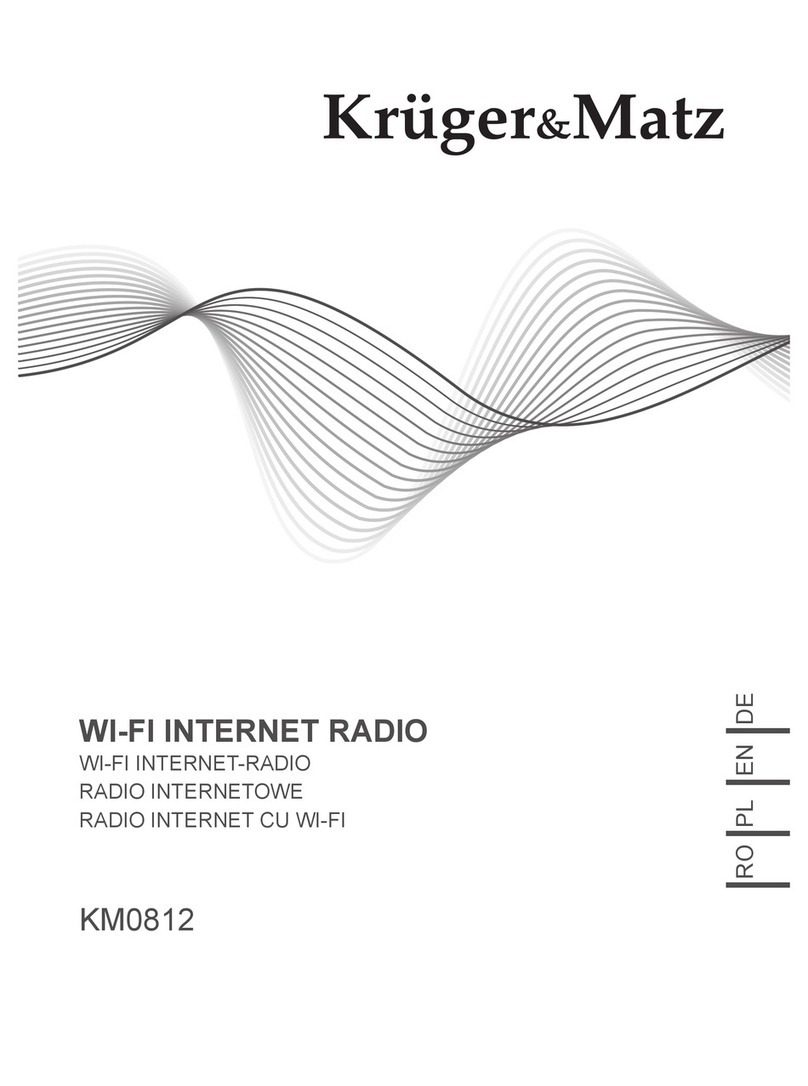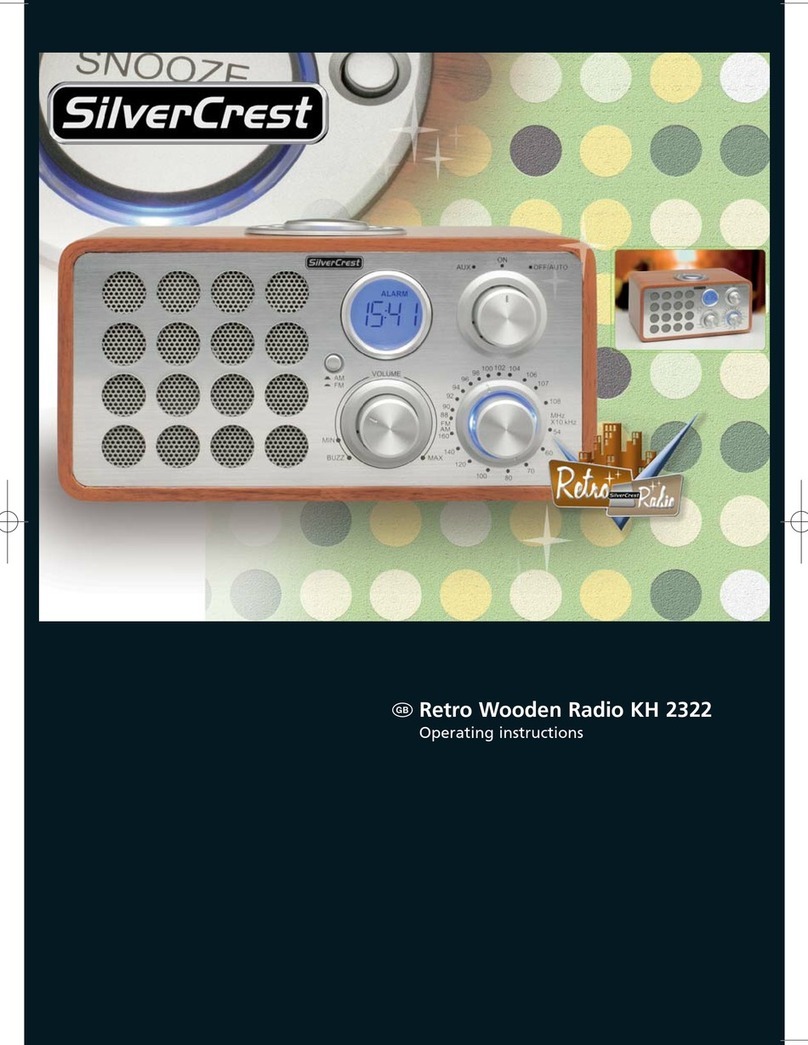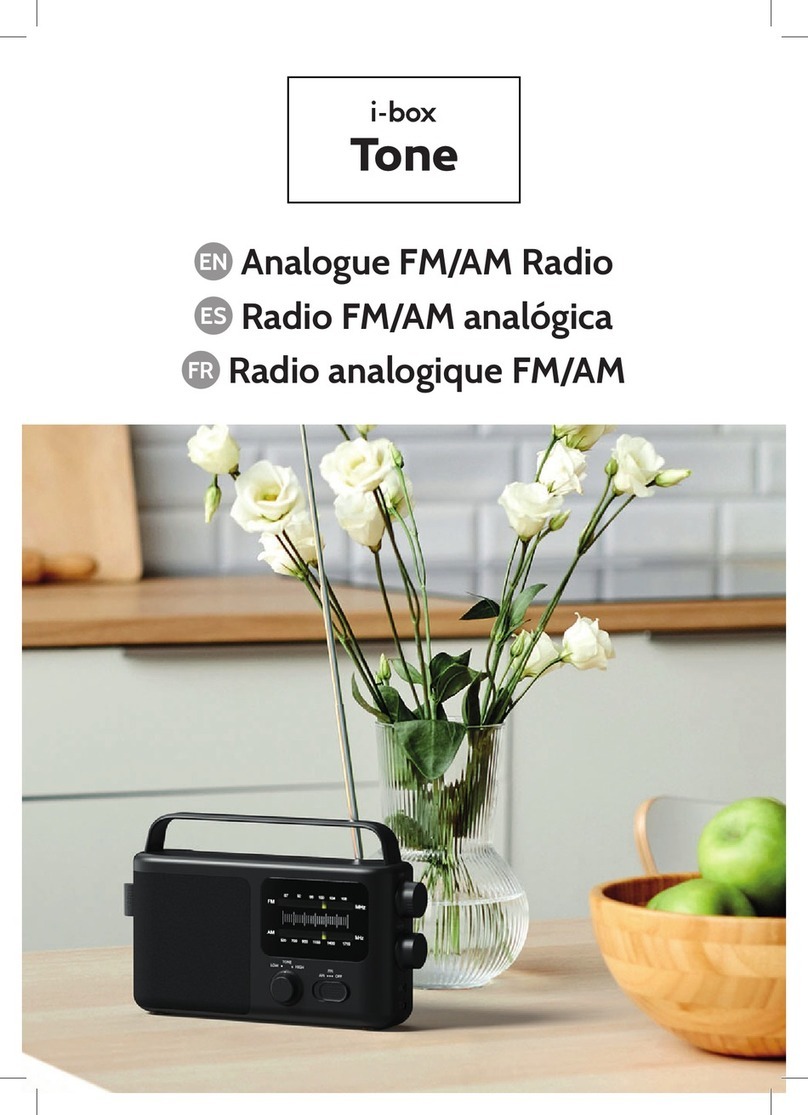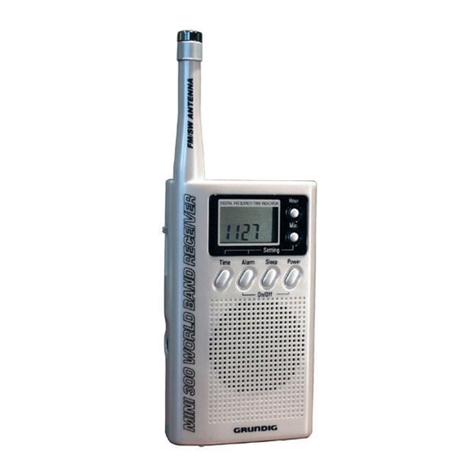DIGITIZE RAD-32 User manual

Digitize, Inc.
158 Edison Road
Lake Hopatcong, NJ 07849-2217
The DIGITIZE logo is a registered trademark of Digitize, Inc.

PROPRIETARY NOTICE
AND DISCLAIMER
DIGITIZE, INC.
158 EDISON ROAD
LAKE HOPATCONG, NJ 07849-2217
PH: (973) 663-1011
E-Mail: info@digitize-inc.com
Website: http://www.digitize-inc.com
This manual has been prepared by DIGITIZE, INC. for use by its licensees, distributors and
customers. The information contained herein is the property of DIGITIZE, INC. and may not
be copied, disclosed or reproduced, in whole or in part, without the prior written approval of
DIGITIZE, INC. Any unauthorized disclosure to, or use of the enclosed information by,
unauthorized third persons shall void any and all representations, warranties and obligations
on the part of DIGITIZE, INC.
DIGITIZE, INC. reserves the right to make changes to the specifications and material
contained herein without prior notice. The information and/or examples (including, but not
limited to circuitry, wiring diagrams, programming, the operation or use shown) described in
this manual are intended solely to illustrate the operating principles of the particular product.
They are not a warranty, representation or guarantee that a particular example or use shown
will perform in a particular situation. They are given for illustration purposes only. DIGITIZE,
INC. shall not be responsible, nor does it represent, that any example of illustration will perform
in a particular environment or practice unless it specifically makes a representation to that
effect.
The material set forth herein is for informational purposes only, and DIGITIZE, INC.
assumes no patent liability with respect to any information or illustrations contained herein.

FCC NOTICE
In compliance with Paragraph 15.105 of the FCC Rules and Regulations, the following
notice is provided.
NOTE: This equipment has been tested and found to comply with the limits for a Class A
digital device, pursuant to Part 15 of the FCC Rules. These limits are designed to provide
reasonable protection against harmful interference when the equipment is operated in a
commercial environment. This equipment generates, uses, and can radiate radio frequency
energy, and, if not installed and used in accordance with the instruction manual, may cause
interference to radio communications. Operation of this equipment in a residential area is likely
to cause interference, in which case the user will be required to correct the interference at the
owner's expense.

DIGITIZE, INC. 700178-0000 REV. H 10/21 i
Specifications Subject to Change Without Notice
Table of Contents
1GENERAL INFORMATION...............................................................................1-1
SYSTEM DESCRIPTION.....................................................................................................1-1
RAD-32/64 DESCRIPTION..................................................................................................1-1
OPTIONS.............................................................................................................................1-1
1.3.1 MODULATION..............................................................................................................1-1
1.3.2 ANTENNA ....................................................................................................................1-2
1.3.3 FREQUENCY...............................................................................................................1-2
1.3.4 32 ZONE EOL INPUT CARD (P/N 400601-0001).......................................................1-2
1.3.5 EIGHT-ZONE FORM C RELAY....................................................................................1-2
SPECIFICATIONS ...............................................................................................................1-2
1.4.1 ELECTRICAL ...............................................................................................................1-2
1.4.2 INPUTS........................................................................................................................1-3
1.4.3 FUSES .........................................................................................................................1-3
1.4.4 CONSTRUCTION.........................................................................................................1-3
1.4.5 DIMENSIONS...............................................................................................................1-3
1.4.6 WEIGHT.......................................................................................................................1-3
1.4.7 TEMPERATURE AND HUMIDITY................................................................................1-3
1.4.8 TRANSMITTER............................................................................................................1-4
FCC REQUIREMENTS........................................................................................................1-4
APPLICABLE PUBLICATIONS............................................................................................1-4
2INSTALLATION................................................................................................2-1
HANDLING...........................................................................................................................2-1
CABINET MOUNTING.........................................................................................................2-1
2.2.1 SITE PREPARATION...................................................................................................2-1
2.2.2 DISASSEMBLY PROCEDURE ....................................................................................2-1
2.2.3 MOUNTING..................................................................................................................2-1
WIRING................................................................................................................................2-2
2.3.1 CONDUIT CONNECTIONS..........................................................................................2-2
2.3.2 FIELD WIRING.............................................................................................................2-2
2.3.3 WIRING........................................................................................................................2-2
RF TRANSMITTER AND INTERFACE BOARD...................................................................2-2
2.4.1 GENERAL ....................................................................................................................2-2
2.4.2 WIRING........................................................................................................................2-3
32 ZONE EOL......................................................................................................................2-3
2.5.1 GENERAL ....................................................................................................................2-3
2.5.2 INSTALLATION............................................................................................................2-3
2.5.3 WIRING........................................................................................................................2-3
LCD DISPLAY AND KEYBOARD.........................................................................................2-3
ASSEMBLY..........................................................................................................................2-3
3SYSTEM INITIALIZATION................................................................................3-1
GENERAL............................................................................................................................3-1
ASSEMBLY..........................................................................................................................3-1
CONNECTIONS AND SETTINGS .......................................................................................3-1
3.3.1 ZONE INPUTS .............................................................................................................3-1
3.3.2 ANTENNA ....................................................................................................................3-1
BATTERY INSTALLATION ..................................................................................................3-1

ii DIGITIZE, INC. 700178-0000 REV. H 10/21
Specifications Subject to Change Without Notice
POWER-UP..........................................................................................................................3-1
3.5.1 AC ................................................................................................................................3-1
3.5.2 DC................................................................................................................................3-1
4PROGRAMMING..............................................................................................4-1
PROGRAM INITIALIZATION................................................................................................4-1
PROGRAM ACCESS...........................................................................................................4-1
PROGRAMMABLE FUNCTIONS.........................................................................................4-1
4.3.1 FUNCTION 0 (SETTING BOX NUMBER)....................................................................4-2
4.3.2 FUNCTION 1 (NUMBER OF DIGITS)..........................................................................4-2
4.3.3 FUNCTION 2 (NUMBERS OR ROUNDS)....................................................................4-3
4.3.4 FUNCTION 3 (CHANGE PASSNUMBER) ...................................................................4-3
4.3.5 FUNCTION 4 (SET TIME)............................................................................................4-3
4.3.6 FUNCTION 5 (SET FIRST “TEST BOX” TIME)............................................................4-3
4.3.7 FUNCTION 6 (SET “TEST BOX” INTERVAL) ..............................................................4-4
4.3.8 FUNCTION 7 (SET NUMBER OF CYCLES PER SECOND) .......................................4-4
4.3.9 FUNCTION 8 (SET TILT/TAMPER SENSITIVITY).......................................................4-4
4.3.10 FUNCTION 9 (ZONE INPUT SENSITIVITY)................................................................4-4
4.3.11 FUNCTION 10 (ZONE INPUT SETTLE TIME).............................................................4-5
4.3.12 FUNCTION 11 (BEEP WHEN ALARM)........................................................................4-5
4.3.13 FUNCTION 12 (BEEP CONTINUOUSLY WHILE IN ALARM) .....................................4-5
4.3.14 FUNCTION 13 (BEEP ON AC POWER FAIL)..............................................................4-5
4.3.15 FUNCTION 14 (TROUBLE RELAY).............................................................................4-5
4.3.16 FUNCTION 15 (SELECT RADIO FORMAT) ................................................................4-6
4.3.17 FUNCTION 16 (ALARM TO RELAY)............................................................................4-6
4.3.18 FUNCTION 17 (AC POWER FAILURE DELAY) ..........................................................4-6
4.3.19 FUNCTION 18 (SEND FIRST PREFIX) .......................................................................4-7
4.3.20 FUNCTION 19 (SEND SECOND PREFIX) ..................................................................4-7
4.3.21 FUNCTION 20 (PREFIX TONE TO SEND)..................................................................4-7
4.3.22 FUNCTION 21 (NUMBER OF TIMESLOTS)................................................................4-7
4.3.23 FUNCTION 22 (LOW BATTERY ON AC POWER FAIL)..............................................4-7
4.3.24 FUNCTION 23 (PANEL TROUBLE).............................................................................4-8
4.3.25 FUNCTION 24 (NUMBER OF ROUNDS FOR TEST TRANSMISSION)......................4-8
4.3.26 FUNCTIONS 25-40 (TONE ASSIGNMENTS)..............................................................4-8
4.3.27 FUNCTION 41 (TONE ASSIGNMENT, PANEL TROUBLE) ........................................4-9
4.3.28 FUNCTION 42 (TONE ASSIGNMENT, TAMPER).......................................................4-9
4.3.29 FUNCTION 43 (TONE ASSIGNMENT, BOX TEST) ..................................................4-10
4.3.30 FUNCTION 44 (TRANSMITTER TEST).....................................................................4-10
4.3.31 FUNCTION 45 (MULTIPLE ZONE TRANSMISSIONS)..............................................4-10
4.3.32 FUNCTION 46 (MEMORY RESET)............................................................................4-10
4.3.33 FUNCTION 47 (SETTING ZONE DELAYS)...............................................................4-12
5THEORY OF OPERATION...............................................................................5-1
CONTROLS .........................................................................................................................5-1
5.1.1 TEST............................................................................................................................5-1
5.1.2 READ ...........................................................................................................................5-1
5.1.3 IN/OUT.........................................................................................................................5-1
5.1.4 CLR/SIL........................................................................................................................5-1
5.1.5 BEEPER.......................................................................................................................5-2
OPERATING PROCEDURE ................................................................................................5-2
5.2.1 GENERAL ....................................................................................................................5-2
5.2.2 NORMAL QUIESCENT OPERATION ..........................................................................5-2
5.2.3 ALARM CONDITION....................................................................................................5-2
5.2.4 TROUBLE CONDITION ...............................................................................................5-2

DIGITIZE, INC. 700178-0000 REV. H 10/21 iii
Specifications Subject to Change Without Notice
5.2.5 STANDBY POWER OPERATION................................................................................5-3
5.2.6 AC POWER FAIL AND LOW BATTERY......................................................................5-3
6TESTING ..........................................................................................................6-1
GENERAL............................................................................................................................6-1
ACCEPTANCE TESTING ....................................................................................................6-1
7APPENDIX A TONE FREQUENCIES...............................................................7-1
8APPENDIX B TONE ASSIGNMENTS ..............................................................8-1

iv DIGITIZE, INC. 700178-0000 REV. H 10/21
Specifications Subject to Change Without Notice

DIGITIZE, INC. 700178-0000 REV. H 10/21 1-1
Specifications Subject to Change Without Notice
1 GENERAL INFORMATION
SYSTEM DESCRIPTION
The overall system is known as the Digitize Radio Fire Alarm System and consists of a Digitize
SYSTEM 3505 Prism Lx, together with a Digitize Mark 6 Radio receiver. The system can
accommodate both AM (Amplitude Modulated) or FM (Frequency Modulated) radio boxes. A
receiver and antenna are also required at the receiving console location. The maximum
number of Radio Alarm Boxes each console can support is 2000 with the appropriate number
of receivers installed. The overall system is intended for use as a Public Fire Reporting system
per NFPA 1221.
RAD-32/64 DESCRIPTION
The RAD-32 and RAD-64 are microprocessor based coded radio boxes, capable of
monitoring 32 or 64 supervised input points. Input points may be added to the RAD-32 to
make it a RAD-64. Also supervised are AC power,Ground, and Battery Faultconditions. Each
standard model is housed in a painted steel enclosure with a hinged door, and is supplied with
a step-down AC transformer, tamper switch, cam lock, rechargeable battery pack rated for 60
hours and an integral battery charger.
The following assemblies make up a RAD-32/64: LCD display and keyboard P/N 400373-
0000, Microcontroller board P/N 400464-0000, 32 Zone Input Board P/N 400601-0001 (two for
RAD-64), Transformer Assembly P/N 450449-0001, 12 Volt 12 AH battery P/N 900414-0006,
Switching Power Supply P/N 400467-0001, AM transmitter P/N 450387-0001 (72-76 MHz) or
450387-0002 (136-174 MHz) or an FM transmitter P/N 450390-0000.
The Microcontroller board is a microprocessor based controller board. A program that
resides in an EPROM program chip controls all functions of the RAD-32/64. This flexibility in
the product allows the user to select such things as output format, set box number, etc. The
transmitter assembly provides all power output regulation. The transmitter will provide 1-Watt
output even at 10.5 VDC of battery voltage. The AM transmitter has a piggyback tone card to
produce all required tones. The tones are produced via an on-board crystal oscillator and
programmable divider circuits. The transformer assembly provided is used to step down the
120 VAC input voltage to 14 VAC required for proper operation of the RAD-32/64. The sealed
lead acid battery supplied provides the required 12.6 VDC for battery backup. The battery is
a 12 Amp Hour battery and will operate the RAD-32/64 for a minimum of 60 hours during an
AC failure. The LCD and keyboard allows the operator to view Alarm and Trouble information
on a 32-character display. The keypad provides access to field programmable functions for
the RAD-32/64.
OPTIONS
1.3.1 MODULATION
The RAD-32/64 may be ordered for AM or FM operation.

RAD-32/64 INSTALLATION AND USER MANUAL
1-2 DIGITIZE, INC. 700178-0000 REV. H 10/21
Specifications Subject to Change Without Notice
RAD-32 425127-0011, 72-76 MHz, AM
425127-0012, 138-174 MHz, AM
425127-0013, 72-76 MHz, FM
RAD-64 425129-0011, 72-76 MHz, AM
425129-0012, 138-174 MHz, AM
425129-0013, 72-76 MHz, FM
1.3.2 ANTENNA
External Mount 900489-xxxx, 72-76 MHz
900491-xxxx, 138-176 MHz
1.3.3 FREQUENCY
Frequency must be selected when order is placed. RAD-32/64 is available in 72-76 MHz
range and 138-174 MHz range.
1.3.4 32 ZONE EOL INPUT CARD (P/N 400601-0001)
The 32 Zone Input Card provides lightning protection for each zone. Each RAD-32 contains
one 32 Zone EOL card. A RAD-64 contains two cards. The RAD-32 can be expanded to a
RAD-64 at any time.
1.3.5 EIGHT-ZONE FORM C RELAY
The Eight Zone Form C Relay board provides eight non-supervised Form C outputs. Up to
eight relay boards may be added to the RAD-32/64 panels, although additional cabinetry and
power may be necessary. The relay contacts are rated 24 VDC at 1.25 Amp for a resistive
load and 125 VAC at .4 amp for an inductive load.
P/N 400375-0001, 1 Amp
P/N 400375-0002, 5 Amp
SPECIFICATIONS
1.4.1 ELECTRICAL
Primary Power Input 120 VAC
Operating Power Consumption (pri) 150 Milliamps (max.)
Standby Battery (BATT) 12 Volt sealed lead acid
Standby 60 hours
Standby calculations are based on normal operation. During normal operation the RAD-
32/64 test in once each day. The RAD-32/64 draws more power while transmitting. Additional

RAD-32/64 INSTALLATION AND USER MANUAL
DIGITIZE, INC. 700178-0000 REV. H 10/21 1-3
Specifications Subject to Change Without Notice
power (350 Ma) is needed for less than three seconds per three rounds transmitted. Overall,
this additional power draw is insignificant over a 24 hours period.
1.4.2 INPUTS
AC Power (terminal block provided)
Low Voltage AC from transformer secondary (AC PWR IN)
Standby battery (+/-)
Supervised Zone Inputs (ZN 1 –ZN 64)
Keyboard and Display Interface (P0)
Expansion Board Interface (P3)
Radio Transmitter Interface (P3)
1.4.3 FUSES
F1, Fuse 0.5 A Fast blow
F2, PTC with Auto reset .5 Amp
F3, PTC with Auto reset .5 Amp
1.4.4 CONSTRUCTION
Welded 0.063-in. steel hinged access door with Cam lock and baked enamel finish. The
inner door holds the transmitter and microcontroller board. The inner door is hinged to allow
easy removal. The enclosure is intended for indoor use only. An optional NEMA 3R enclosure
is available. The RAD-32/64 is placed inside of the NEMA 3R enclosure.
1.4.5 DIMENSIONS
Height 25.0 in. (63.50 cm)
Width 12.00 in. (30.48 cm)
Depth 5.5 in. (13.97 cm)
1.4.6 WEIGHT
Net Weight (without battery) 31.0 lbs.
Net Weight (with battery) 36.0 lbs.
1.4.7 TEMPERATURE AND HUMIDITY
Operating Temperature Range -40 to + 60 Degrees Celsius
Storage Temperature Range -40 to +60 Degrees Celsius
Operating Humidity Range 0 to 90% (non-condensing)
Storage Humidity Range 0 to 90 % (non-condensing)
1
-
3

RAD-32/64 INSTALLATION AND USER MANUAL
1-4 DIGITIZE, INC. 700178-0000 REV. H 10/21
Specifications Subject to Change Without Notice
1.4.8 TRANSMITTER
RF Output Power (ANT) 1.0 Watts (max)
FCC REQUIREMENTS
The RAD-32/64 complies with the limits set for a Class B computing device as specified in
Subpart J of Part 15 of the FCC Rules and Regulations. This unit also complies with Part 90
of the FCC Rules and Regulations.
APPLICABLE PUBLICATIONS
FCC Rules and Regulations, Parts 15 and 90
National Electric Code 1990
NFPA 1221

DIGITIZE, INC. 700178-0000 REV. H 10/21 2-1
Specifications Subject to Change Without Notice
2 INSTALLATION
HANDLING
1.1.1. PRECAUTIONS
1.1.2. UNPACKING AND INSPECTION
Before opening, inspect the shipping container for unusual damage. Then, carefully unpack
the unit and inspect it for scratches, dents, and loose internal components. If your inspection
reveals any physical damage, retain the packing material and contact the shipping carrier
immediately. Each unit has been thoroughly inspected before shipment.
NOTE: Keep unit in shipping container until ready to mount.
CABINET MOUNTING
2.2.1 SITE PREPARATION
The installation area should be well lit, clean, easily accessible, and free from extremes of
temperature and humidity. Please refer to Section 1.4.7, Temperature and Humidity.
2.2.2 DISASSEMBLY PROCEDURE
1. Retrieve the unit from its shipping container and place the back of the unit down on a flat
surface.
2. Using a CAT-1 key, (2 are supplied with each unit in an envelope marked (“KEYS”) open
the hinged door.
3. Remove the ribbon cable plug from connector P3.
4. Open the hinged door, lift up to remove. Secure the LCD display and keyboard panel.
5. Put the LCD display and keyboard into the shipping container until the unit is mounted.
2.2.3 MOUNTING
The cabinet supplied with the standard model is designed for surface mounting. The
mounting area must be a smooth and clean surface of a permanent partition. The cabinet
must be securely fastened to the mounting surface using the four mounting holes. For this,
CAUTION!! DO NOT TOUCH the circuitry on the board during installation
as static discharge may damage components.
2
-
1

RAD-32/64 INSTALLATION AND USER MANUAL
2-2 DIGITIZE, INC. 700178-0000 REV. H 10/21
Specifications Subject to Change Without Notice
#10 or l/4 inch screws are suggested. The mounting location should be planned to allow full
access to the top, bottom, and sides forease of conduit entry. Whenmounted,panelindicators
and labels should be plainly visible and the cabinet door must be able to swing to the full open
position. Following these guidelines will facilitate ease in installation, operation, and
maintenance.
WIRING
2.3.1 CONDUIT CONNECTIONS
Connect all wiring conduits to the cabinet in accordance with applicable National Electric
Code, state and local building code requirements. The cabinet is supplied with pre-stressed,
l/2”, knockouts. Please note that the lower shelf of the cabinet is used primarily for stand-by
battery placement. If the bottom shelf must be used for conduit entry, make sure the wiring
does not interfere with battery installation.
2.3.2 FIELD WIRING
Pull power feeds and all field wiring thought the conduit and into the cabinet. It is important
that the field wiring for the zone inputs be isolated from power and telephone lines. Field wiring
for each zone input should be limited to less than 1000 feet in length.
All field wiring must be tested for grounds, induced voltages, open and shorted circuits. All
field wiring must be free of these conditions before connecting them to peripheral devices or
to the RAD-32/64. Do not connect field wiring until the panel has been fully tested beforehand.
Tag all wiring for later connection to the unit. Please refer to Section 3, System Initialization.
Failure to comply with these guidelines may cause damage to the unit.
2.3.3 WIRING
BS1 - These terminals are the normally closed, common, and normally open contacts of
the auxiliary trouble relay (K1).
CONNECTOR P0 - This connector is used to interface to the expansion zone boards via
ribbon cable. This connector is keyed so the plug may only be inserted one way.
CONNECTOR P1 - The AM transmitter uses this connector for radio communication. The
connector is keyed so the plug may only be inserted one way.
CONNECTOR P3 - This connector is used to connect the LCD display and keyboard. This
connector is keyed so the plug may only be inserted one way.
CONNECTOR P4 - This connector is used to connect the power supply board (P/N
400464). The connector is keyed so the plug may only be inserted one way.
RF TRANSMITTER AND INTERFACE BOARD
2.4.1 GENERAL
This assembly is the radio transmitter and interface for the RAD-32/64. Two transmitter
types, (AM or FM) are available. The wiring for both units is the same.

RAD-32/64 INSTALLATION AND USER MANUAL
DIGITIZE, INC. 700178-0000 REV. H 10/21 2-3
Specifications Subject to Change Without Notice
2.4.2 WIRING
Field wiring for this unit consists of an antenna cable only. The antenna cable must be
tested for ground faults, open circuits and shorted circuits before connecting to the RAD-32/64.
32 ZONE EOL
2.5.1 GENERAL
Each 32 Zone EOL may be switch selected for zone groups of 32. A RAD-32 is supplied
with one 32 Zone EOL (expandable to two). A RAD-64 is supplied with two 32 Zone EOL
boards.
2.5.2 INSTALLATION
Refer to Section 2.6.2 for installation procedure.
2.5.3 WIRING
BS1-BS8 - Barrier strips BS1 - BS8 contain terminals for the connection of field wiring to
the Class B zone initiating inputs. Zone numbering for the 32 ZONE EOL is supplied
with the system. For additional boards, terminal designations increase by 32 for each
expansion board.
LCD DISPLAY AND KEYBOARD
A LCD (liquid crystal display) and keypad is supplied with each RAD-32 or RAD-64 units.
Only one LCD display and keypad may be used per panel.
ASSEMBLY
1. Retrieve the LCD display and mounting screws from the shipping container.
2. Place the front panel over the mounting holes and start the top left and top right mounting
screws.
3. Start the lower left and lower right screws.
4. Align the LCD display panel and tighten the mounting screws.
5. Connect the ribbon cable plug of the LCD display to P3 of the main board.
CAUTION!! A wiring trouble cannot be distinguished from an
initiating device trouble. Acceptability is at the discretion of the authority
having jurisdiction.
2
-
4

RAD-32/64 INSTALLATION AND USER MANUAL
2-4 DIGITIZE, INC. 700178-0000 REV. H 10/21
Specifications Subject to Change Without Notice
Figure 2.1 - RAD-32/64 Door Label

DIGITIZE, INC. 700178-0000 REV. H 10/21 3-1
Specifications Subject to Change Without Notice
3 SYSTEM INITIALIZATION
GENERAL
For initial set-up of the RAD-32/64, complete the following instructions in the order in which
they appear. However, if it is necessary to set the time on the internal clock during the
operation of the unit, the time can be set without going through the power-up sequence.
ASSEMBLY
Mount the front panel, (if not already installed), on the hinge assembly.
CONNECTIONS AND SETTINGS
3.3.1 ZONE INPUTS
An end-of-line resistor should be connected across each pair ofzone input terminals. There
are two screw terminals for each zone input. The zone inputs CAN NOT have any terminals
connected to system common. After testing the unit, remove the EOL resistors supplied with
the unit and place one on the last device of each zone-input line. If the resistor is not moved
and field wiring is installed on the line, the line will not be supervised.
3.3.2 ANTENNA
The antenna coaxial cable should be connected to the AM transmitter.
BATTERY INSTALLATION
The standby battery is installed on the lower shelf of the cabinet.
POWER-UP
3.5.1 AC
Place the AC circuit breaker or local power disconnect switch in the OFF position. Connect
the AC power wires to the terminal blocks provided for the AC input. Apply AC power to the
panel.
3.5.2 DC
Connect the battery cable supplied with the panel to battery.
Carefully observe the polarity when connecting the battery cable. (RED = positive, BLACK
= negative).
3
-
1

RAD-32/64 INSTALLATION AND USER MANUAL
3-2 DIGITIZE, INC. 700178-0000 REV. H 10/21
Specifications Subject to Change Without Notice

DIGITIZE, INC. 700178-0000 REV. H 10/21 4-1
Specifications Subject to Change Without Notice
4 PROGRAMMING
PROGRAM INITIALIZATION
Upon power-up, the RAD-32/64 panel will display the number of input boards installed.
Verify that all of the input boards on the panel are on the display. Press the “CLEAR” button
to continue. The time will appear on the display along with any alarm and fault conditions that
the DGM finds during its initialization process.
The “WATCH DOG” or “RESET” LED will flash momentarily every several seconds to
indicate that all elements in the panel are operating correctly.
PROGRAM ACCESS
To add, delete, or display the functions available to the RAD-32/64:
1. Using the numeric keypad, enter the system password: “123456”.
2. Press the Enter button.
3. If the password was entered correctly, “ACCESS GRANTED” will appear on the display.
Access to the programming area will be provided for five minutes. If the password was
entered incorrectly “ENTER PASSNUMBER’ will be on the display.
PROGRAMMABLE FUNCTIONS
The programmable functions available for the RAD-32/64 are detailed in this section. To
access a function, enter the number of the function and press ENTER. The display will indicate
the current value programmed for that function.
FUNCTION SELECTION
0 Setting Radio Box Number
1 Setting Number of Digits in Box Number
2 Setting Number of Rounds per Radio Transmission
3 Changing the Pass number
4 Set Time of Day
5 Set Time of First Test Box Transmission
6 Set Time between Test Box Transmissions
7 Set Number of Cycles Per Second
8 Set Tilt/Tamper Sensitivity
9 Set Zone Input Sensitivity
10 Set Zone Input Settle Time
4
-
1

RAD-32/64 INSTALLATION AND USER MANUAL
4-2 DIGITIZE, INC. 700178-0000 REV. H 10/21
Specifications Subject to Change Without Notice
11 Beep When Any Zone In Alarm
12 Beep Continuously While Any Zone In Alarm
13 Beep on AC Power Failure
14 Trouble Relay
15 Select Radio Transmission Format
16 Alarm Relay
17 Delay Transmission of AC Power Failure (Digitize Format)
18 Send First Prefix
19 Send Second Prefix
20 Prefix Tone to Send First
21 Number of Time Slots
22 Send Low Battery Transmission on AC Power Failure
23 Send Panel Trouble Transmission When Any Zone In Trouble
24 Number of Rounds for Test Box Transmission
25-40 Radio Tone Assignments
41 Tone Assignment, Panel Trouble
42 Tone Assignment, Tamper
43 Tone Assignment, Box Test
44 Radio Transmitter Test
45 Send Multiple Zones for Radio Transmission (Digitize Format)
46 Reset Setting to Factory Defaults
47 Set Zone Delays
4.3.1 FUNCTION 0 (SETTING BOX NUMBER)
This function is used to set the “Box” number to be transmitted by the RAD-32/64 Radio
Alarm Transmitter. The number must be entered in a six-digit format. Box numbers with less
than six digits must be prefixed by zeros.
Examples: For a box number of 28, enter: “000028” For a box number of 12345, enter
“012345”
The default setting for Function 0 is 654321.
To view or change the Box number, press “0” then ENTER”. The display will read “FUNC
0 =XXXXXX’. To change the Box number, enter the new number on the keypad and press
“ENTER”. The new Box number should now be displayed. Press “CLEAR” at any time to abort
changes.
4.3.2 FUNCTION 1 (NUMBER OF DIGITS)
This function sets the number of digits that the RAD-32/64 will transmit as its box number.
The number of digits set for this function must be equal to or greater than the number of digits
This manual suits for next models
1
Table of contents
Popular Radio manuals by other brands

Roberts
Roberts Gemini 55 RD-55 user manual
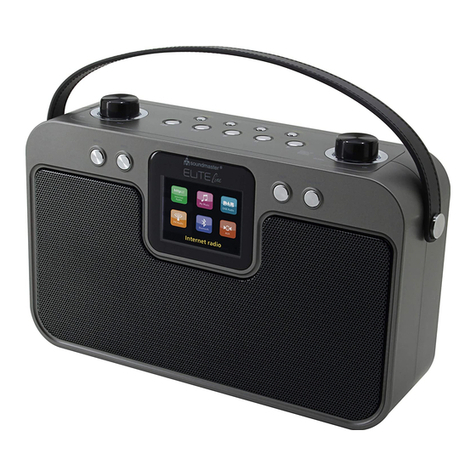
SOUNDMASTER
SOUNDMASTER ELiTEline IR4400 instruction manual

SILENTRON
SILENTRON 5532 Sirenya quick start guide
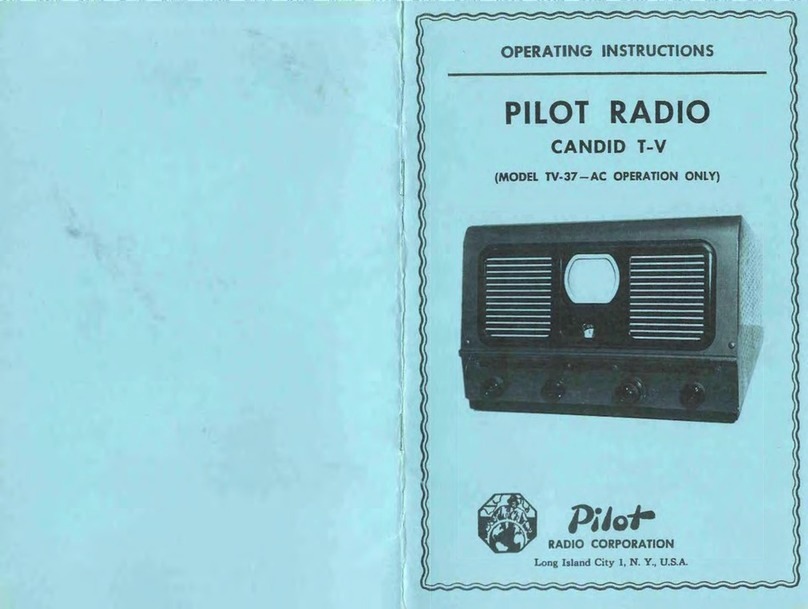
Pilot Communications
Pilot Communications TV-37 operating instructions
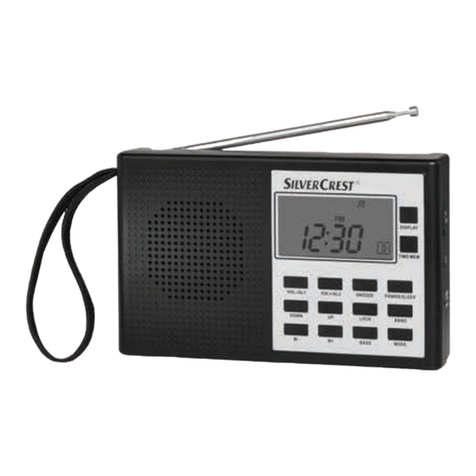
Silvercrest
Silvercrest SWED 500 A1 User manual and service information
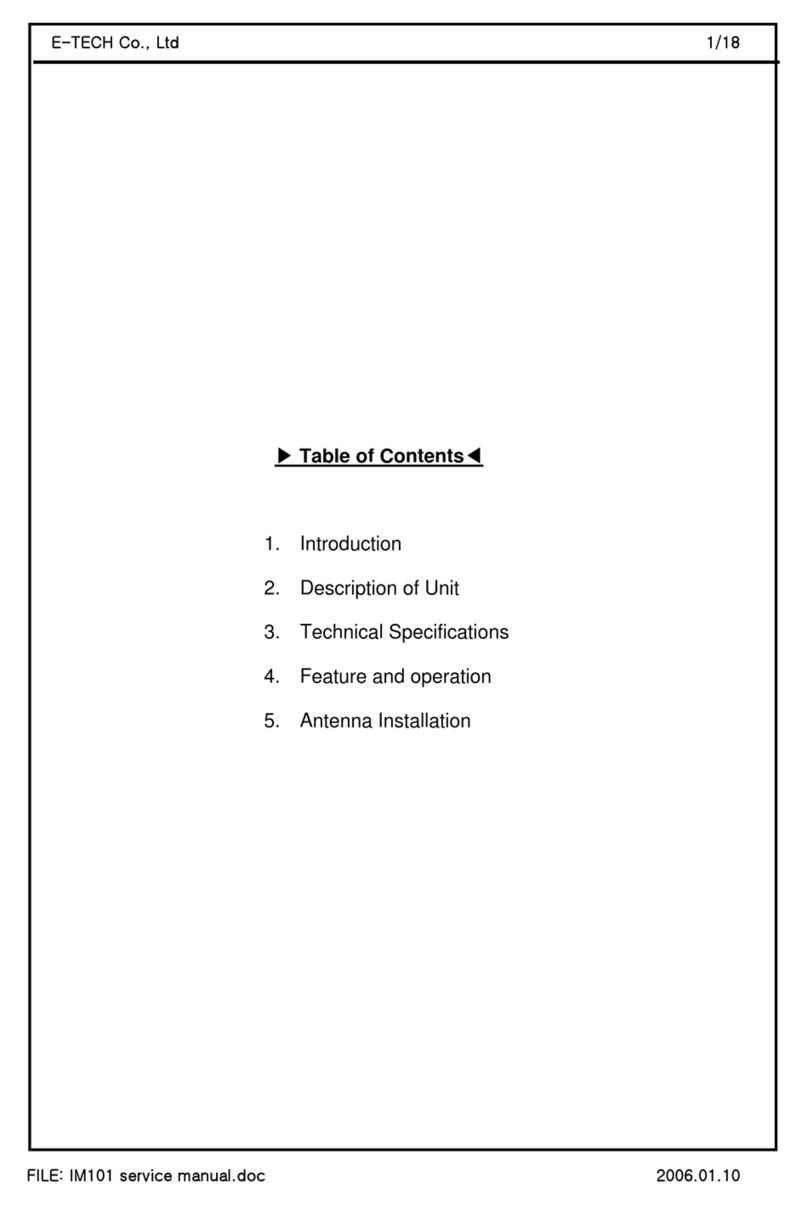
E-Tech
E-Tech IM101 Service manual

